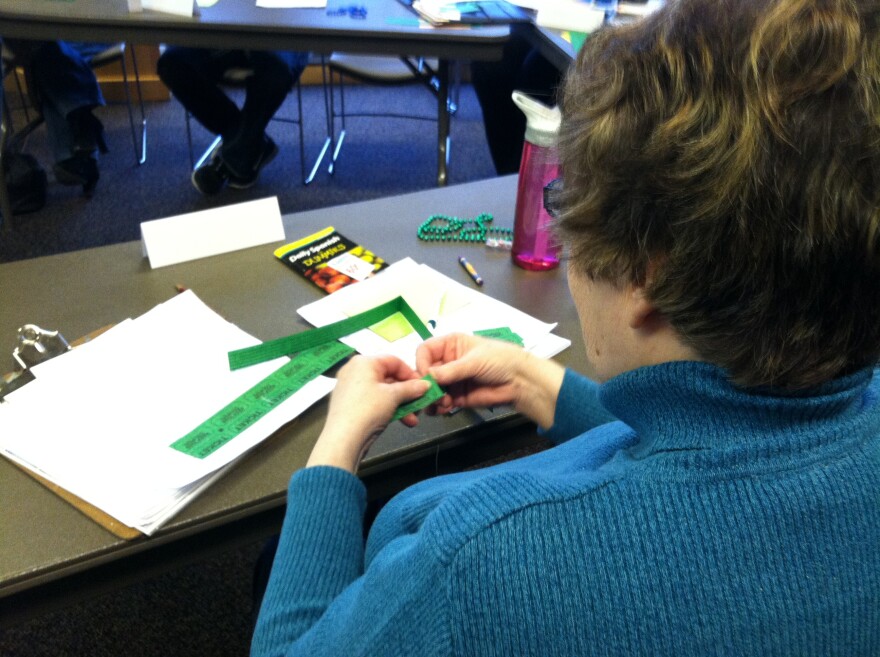Some South Dakota students take Spanish classes as early as kindergarten. Children learn a second language for all sorts of reasons relating to cognition and life skills. But people who didn’t have that opportunity in school still find a need to become bilingual later in life.
A dozen people slide into chairs at tables pushed end-to-end. Their ages vary, and so do their backgrounds. They’re all at Los Paisanos 2 in Sioux Falls for the same reason. Peggy Hofmeister sits near a window as she peruses the menu.
"I’m here with my…se llama Larry," Peggy Hofmeister says.
Peggy and her husband Larry Hofmeister are hungry, but they’re mostly focused on accurately reading the menu, which is in Spanish. The couple visits Mexico every few years, and the Hofmeisters want to be able to communicate.
"A little bit more than just ‘hola’ is nice," Peggy Hofmeister says. "That’s all we’ve been able to say so far."
"We bump into the maids in the hallway, and it’d be nice to visit with them just a little bit because they’re working hard and making our trip so much better when we’re there," Larry Hofmeister says.

The Hofmeisters are completing a vacation Spanish class. Larry says a meal with fellow Spanish students reinforces the material they’ve worked on for six weeks.
"We came in with no prior experience, and we picked up phrases," Larry Hofmeister says. "Our pronunciation is not very exact. But the waitress understood what we were trying to do. If I see the word, I can kind of sort out what it means sometimes."
That’s a long way from where they started a couple of months ago; they each had a dash of Spanish in high school decades before this course. The Hofmeisters claim they intended to study this time, but they never followed through. Peggy Hofmeister says she’s still amazed by how much she now speaks and understands.
"I’m still intimidated, because I’m not very good at it at all. And, to listen to Chris, I’m going, ‘What?’" Peggy Hofmeister says. "But every once in a while, you’ll catch a word that you do know, so then you realize ‘Okay, he’s talking about what we’re going to drink,’ because we picked up the word ‘beber.’"
The "Chris" she refers to is the class instructor.
"Me llamo Chris Coughlin. Soy un profesor de espanol," he says. "I’m Chris Coughlin, a Spanish teacher for the Sioux Falls School District. I also just started with community ed doing Spanish classes both for kindergarten and adult vacation Spanish."
Coughlin says a class rooted in basic conversation is different than typical Spanish classes where students learn to conjugate verbs and study vocabulary.
"[Saying] a little bit more than just 'hola' is nice," student Peggy Hofmeister says.
"My goal really was to find out what they needed, what they were anticipating needing, what they had found out from experience needing while on vacation to be able to say in Spanish, to be able to communicate with native speakers that might not understand some of the more complex words or thoughts, expressions," Coughlin says.
A primary reason Coughlin even teaches this course sits feet away. Student Terri Fisher completed two Spanish classes before, but she wanted a course that teaches basic conversation. Fisher says a class designed not solely on the mechanics of the language, but on communicating in Spanish would make her travels less frustrating.
"It would have totally been easier. My husband and I, one time, were on a bus and could not convey enough to the bus driver got completely off track, and it was hard to get back," Fisher says. "So that was the first thing that sparked it. I want to know how to say where’s the bus stop and how do I get off and where I want to go."
Fisher says she appreciates the camaraderie this conversational Spanish class creates.
"Even if you made a mistake, it wasn’t that you felt self-conscious about it. You just knew that that was how you’re going to learn," Fisher says. "So if you don’t try, you’re not going to learn. Everyone in here was, I think, fearless about trying."
Because dialogue is the foundation for the course, students participate in lessons molded around real-life situations they encounter on Spanish-speaking excursions. In one scenario, students buy and sell merchandise. Students, including Stephanie Weber, put into practice their new skills talking money, goods, and manners.
"I did rather well, I thought," Weber says. "I think some people overpaid for my merchandise, but I guess that’s the good salesman in me."

Weber sold a lot of clothing in the classroom activity, and she’s proud of her limited Spanish skills. Weber has zero familiarity with the language but she sees opportunities in everyday life.
"There are incidences on the street, in an apartment building, wherever that there are Spanish-speaking people all over our city, and I think that could very much come in handy," Weber says.
Now Weber puts that practice to the test. At the restaurant with her class, Weber – talking in Spanish – orders with the Spanish-speaking server. She admits she has an element to her talent that can’t be seen on the radio, and she’ll bring it along when she visits her daughter who’s with the Peace Corps in Guatemala.
"I have a cheat sheet!" Weber says.
Weber praises her classmates and her instructor for creating an inviting and comfortable environment to tackle learning a new language. Her instructor, Chris Coughlin, credits the students.

"I had people ranging from they just needed a little practice to they needed work with just basic introductions," Coughlin says. "So it was a fun class, and they really helped each other a lot, and it was really fun to see that."
Coughlin says people can easily overcome the intimidation of learning a new language with a little practice. Then, he says, travels around the world or casual conversations near home become relaxed and enjoyable.


